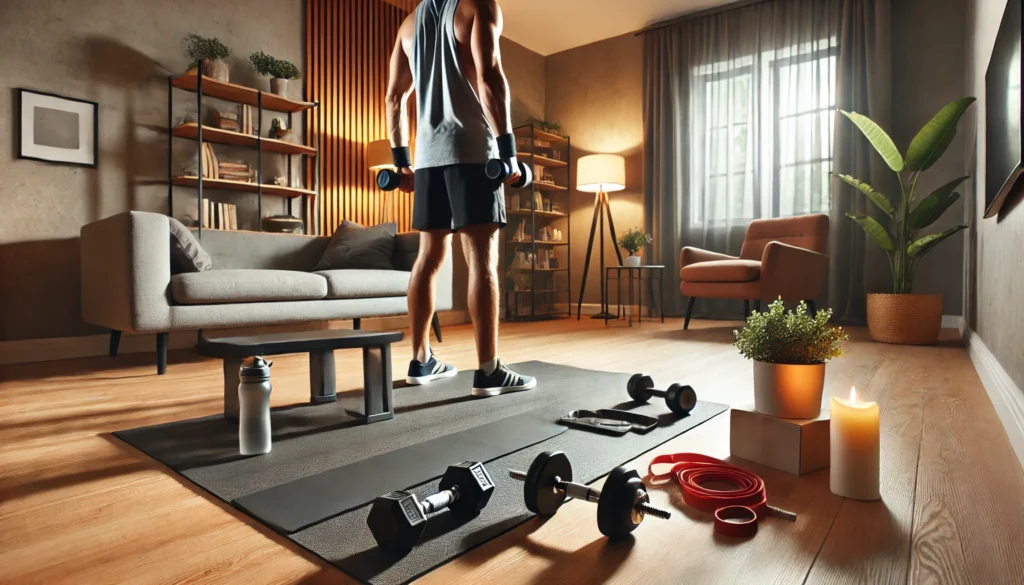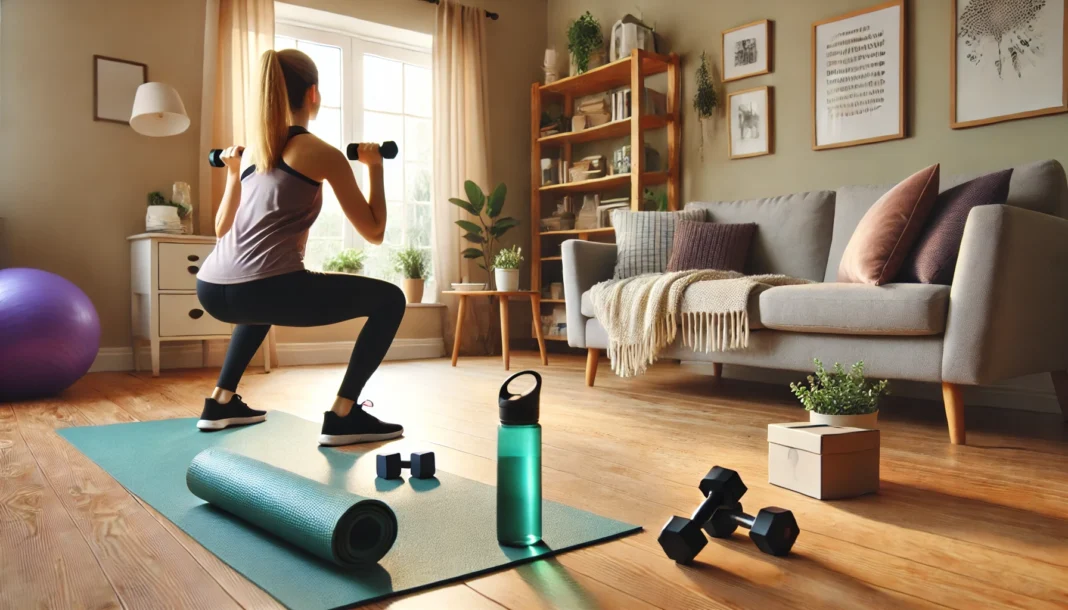Introduction: Building Strength and Performance with a Home Gym Weight Set
Investing in a home gym weight set is one of the most effective ways to enhance strength and performance without relying on commercial gym access. As fitness continues to evolve, more individuals are turning to home weight sets to achieve their workout goals while maintaining convenience and consistency. Selecting the right set requires a thorough understanding of key factors, including material quality, adjustability, space efficiency, and individual training needs. With a well-chosen home weightlifting set, anyone from a beginner to an advanced athlete can create a tailored workout routine that delivers measurable results.
You may also like: The Ultimate Bodyweight Workout Routine for Full-Body Strength and Performance
This guide will explore every essential consideration when purchasing a home gym weight set, from evaluating different weight types to understanding the biomechanics of resistance training. Whether you seek compact dumbbells for light resistance work or a complete home weight set for serious powerlifting, this article will equip you with the knowledge to make an informed choice.
Understanding the Types of Home Weights and Their Benefits
The first step in selecting the right home gym weight set is understanding the variety of available weights and their benefits. Traditional free weights, including dumbbells, barbells, and kettlebells, remain the cornerstone of strength training due to their versatility and ability to engage stabilizing muscles. Adjustable dumbbells are an excellent option for those with limited space, as they provide a wide range of weight options within a single compact design. Fixed-weight dumbbells and barbells offer durability and a straightforward approach to lifting but require more storage space.
Kettlebells, another popular choice, are ideal for dynamic movements that build functional strength, including swings, snatches, and presses. For those interested in resistance training with incremental progression, a plate-loaded home weightlifting set allows for precise adjustments and gradual strength increases. Understanding these different options ensures that individuals select a home weight set tailored to their specific fitness goals and available workout space.
How to Choose the Best Home Gym Weight Set for Your Fitness Level
Selecting a home weight set that aligns with your current fitness level and future progression is crucial for long-term success. Beginners should start with a basic set that includes a range of light-to-moderate weights to allow for gradual strength development. Adjustable dumbbells or a simple barbell with weight plates provide enough versatility without overwhelming new lifters. Intermediate users who have established a consistent training routine may benefit from expanding their home weights collection to include heavier dumbbells, a full barbell set, or kettlebells for diversified training.
For advanced lifters, investing in a high-quality home weightlifting set with Olympic-standard barbells and bumper plates is essential for maximizing strength gains. The ability to load progressively heavier weights ensures continued adaptation and performance improvements. Regardless of experience level, individuals should prioritize high-quality materials and ergonomic designs to minimize the risk of injury and maximize lifting efficiency.
Optimizing Strength Training with a Home Weightlifting Set
Maximizing the effectiveness of a home gym weight set requires strategic programming and proper execution of fundamental lifting techniques. Compound movements such as squats, deadlifts, bench presses, and rows form the foundation of any strength program and should be prioritized for overall muscle development. Incorporating progressive overload, where resistance is gradually increased over time, ensures continuous adaptation and strength progression.
Additionally, integrating different training methods such as supersets, drop sets, and tempo variations helps prevent plateaus and enhances workout intensity. By consistently challenging the muscles with varied stimuli, lifters can optimize performance and maintain steady strength gains. Recovery also plays a vital role in effective weightlifting, with adequate rest periods and proper nutrition being essential for muscle repair and growth.

Space Considerations and Storage Solutions for Home Weights
When investing in a home weight set, assessing available space and storage options is essential to maintaining an efficient workout environment. Compact adjustable dumbbells and stackable weight plates are ideal for small home gyms, as they provide a range of resistance levels without occupying excessive space. Wall-mounted storage racks and vertical dumbbell stands help keep equipment organized and easily accessible, ensuring a clutter-free workout area.
For those with dedicated home gym spaces, investing in a full-size power rack with integrated weight storage can provide a professional-grade training environment. Ensuring that flooring is reinforced with rubber mats or lifting platforms protects surfaces from heavy weights and minimizes noise disturbances. Thoughtful organization and efficient storage solutions enhance the overall home training experience, making it easier to stay consistent with workouts.
The Importance of Quality and Durability in Home Gym Weight Sets
Durability and material quality play a significant role in the longevity and effectiveness of a home gym weight set. Cast iron and rubber-coated weights are among the most durable options, providing excellent resistance to wear and tear while minimizing damage to flooring. Urethane-coated dumbbells and bumper plates offer an additional layer of protection and are often used in high-impact environments due to their shock-absorbing properties.
Choosing weight sets with knurled handles ensures a secure grip, reducing the likelihood of slipping during heavy lifts. Welded construction and reinforced barbell sleeves contribute to the structural integrity of weightlifting equipment, preventing premature failure. Investing in a high-quality home weight set pays off in the long run by providing reliable performance and reducing the need for frequent replacements.

Frequently Asked Questions (FAQ) on Home Gym Weight Sets
1. How do I choose the right home gym weight set for my fitness level? Selecting the ideal home gym weight set requires a thorough understanding of your current strength levels, future progression, and workout preferences. Beginners may benefit from adjustable dumbbells, which offer flexibility and allow for gradual increases in resistance without requiring a vast collection of home weights. Intermediate and advanced lifters, however, may need a more comprehensive home weightlifting set that includes barbells, weight plates, and kettlebells for diverse strength training. A key factor to consider is the type of workouts you plan to perform—if you focus on powerlifting, investing in a full barbell and plate set is more beneficial, whereas circuit trainers may prefer a mix of dumbbells and kettlebells. Assessing your fitness journey in stages ensures that you purchase a home weight set that grows with your capabilities and training demands.
2. What are the benefits of using a home weight set instead of a gym membership? Investing in a home weightlifting set provides a level of flexibility and convenience that commercial gyms simply cannot match. Home weights allow you to train at any time without the constraints of gym hours, eliminating long commutes and waiting for equipment. Additionally, owning a home weight set ensures that you can maintain hygiene standards, avoiding the shared sweat and bacteria that come with public gym and weights facilities. Over time, the cost of a quality home weightlifting set is often less than an annual gym membership, making it a wise long-term investment. Furthermore, training in the privacy of your own space fosters better consistency, enabling more focused and distraction-free workouts.
3. How much space do I need to set up a functional home gym weight set? The space required for a home gym weight set largely depends on the type of equipment you choose and the exercises you perform. A compact setup with adjustable dumbbells and resistance bands may fit within a small corner of a room, whereas a complete home weightlifting set with barbells, squat racks, and weight benches requires a dedicated area, such as a garage or basement. A minimum of 6×6 feet is typically recommended for functional strength training with home weights, allowing for adequate movement and safety. If space is limited, consider foldable weight benches and vertical weight storage racks to maximize efficiency. Strategic placement of gym and weights equipment can help create a functional and organized training area without requiring an extensive amount of room.
4. How do I maintain and store my home weight set properly? Proper maintenance of a home weightlifting set ensures longevity and optimal performance. Regularly wiping down barbells and dumbbells prevents rust and corrosion, especially if you train in a humid environment. Investing in rubber or urethane-coated home weights can help protect both the weights and your flooring. Storing weights on racks rather than leaving them on the floor reduces the risk of accidents and keeps the training area organized. If using a home weight set with adjustable plates, ensure that locking mechanisms remain secure to prevent shifting during workouts. Proper care not only extends the lifespan of your gym and weights equipment but also creates a safer and more efficient workout space.
5. Are adjustable dumbbells better than a full home weight set? Adjustable dumbbells offer a space-efficient and cost-effective alternative to traditional fixed-weight dumbbells, making them a popular choice for home gym setups. They allow for quick weight changes, which is beneficial for progressive overload training and high-intensity workout circuits. However, a full home weight set, including barbells and weight plates, provides more versatility for compound lifts like squats, deadlifts, and bench presses. If your fitness goals involve heavy lifting and advanced strength training, a comprehensive home weightlifting set may be a better long-term investment. Ultimately, the decision depends on available space, budget, and the variety of exercises you aim to perform.
6. How can I make my home gym weight set workouts more effective? To maximize the benefits of a home weightlifting set, focus on incorporating progressive overload—gradually increasing weight or repetitions to stimulate muscle growth. Implementing structured workout programs, such as split routines or full-body strength training, ensures balanced muscle development. Varying workout intensity by using supersets, tempo training, and resistance bands can also enhance the effectiveness of home weights. Additionally, paying attention to form and technique prevents injuries and ensures efficient movement patterns. Consistency, combined with proper nutrition and recovery, plays a crucial role in achieving long-term strength and fitness goals.
7. What safety precautions should I take when using a home weight set? Safety is paramount when training with a home gym weight set, especially when lifting heavy loads without a spotter. Ensuring that your workout space has proper flooring, such as rubber mats, can prevent slipping and protect your floors from dropped home weights. Using collars or clips on barbells prevents weight plates from shifting unexpectedly during lifts. When performing heavy compound exercises, consider investing in a power rack with safety bars to catch the weight if you reach muscle failure. Additionally, warming up adequately before training and cooling down afterward reduces the risk of strains and injuries. Practicing controlled movements and avoiding excessive ego lifting can further ensure safe and effective workouts.
8. How do home weights compare to machines for strength training? While resistance machines provide guided movement patterns that reduce the risk of improper form, free weights offer superior muscle activation by engaging stabilizing muscles. A home gym weight set allows for greater range of motion and functional strength development, making it a preferred choice for overall athletic performance. Machines, on the other hand, may be beneficial for beginners or those recovering from injuries, as they provide controlled resistance and minimize the chance of incorrect movement. Home weights also allow for compound exercises like deadlifts, squats, and overhead presses, which translate better to real-life strength applications. Balancing both free weights and machine-based training, when possible, creates a well-rounded strength-building approach.
9. What are the best ways to progress when training with a home weight set? To ensure continuous progress with a home gym weight set, gradually increasing resistance is essential. This can be done by adding more weight, increasing repetitions, or adjusting tempo for time under tension. Incorporating different training modalities, such as pyramid sets or drop sets, challenges muscles in new ways and prevents plateaus. Switching up exercise variations—such as performing sumo deadlifts instead of conventional deadlifts—can further stimulate strength gains. Keeping a workout log to track progress and making periodic adjustments to your training plan ensures sustained improvements in performance. Proper recovery, including adequate sleep and nutrition, complements training efforts and supports muscle growth.
10. Is a home gym weightlifting set a good investment for long-term fitness? A home gym weightlifting set is one of the best investments for individuals seeking long-term fitness and strength development. Unlike gym memberships that require recurring fees, a one-time investment in high-quality home weights provides lifetime accessibility to resistance training. The convenience of training at home increases workout consistency and adherence, leading to better results over time. Additionally, owning a home weight set eliminates the need to commute to a gym, saving both time and money in the long run. By choosing durable, versatile equipment and following a well-structured training plan, individuals can enjoy sustainable progress and long-term physical health benefits.

Conclusion: Creating an Effective Home Gym for Long-Term Strength Gains
Selecting the best home gym weight set is a critical step in building an effective and sustainable workout routine. By understanding the different types of home weights, assessing individual fitness levels, and prioritizing quality, individuals can create a personalized home training environment that supports their strength and performance goals. Thoughtful planning in terms of space efficiency and durability further enhances the experience, ensuring that home workouts remain both productive and enjoyable.
By integrating progressive training techniques and maintaining consistency, anyone can achieve significant strength gains with a well-equipped home weightlifting set. Whether the goal is muscle growth, improved athletic performance, or overall fitness enhancement, a carefully chosen home weight set provides the foundation for lifelong physical development and success.
strength training, home fitness, adjustable dumbbells, barbell workouts, resistance training, fitness equipment, weightlifting tips, strength progression, home gym essentials, muscle development, functional strength, kettlebell training, powerlifting, dumbbell exercises, gym storage solutions, workout efficiency, Olympic weights, progressive overload, home workout optimization, fitness performance.
Further Reading:
Lifting at Home Is Easier Than You Think—Shop the Best Starter Weights Here
How to choose a Home Weight Set in 2025
The Weight Machines You Need For Your Home Gym
Important Note: The content provided by HealthXWire is for informational purposes only and should not be construed as medical advice, diagnosis, or treatment. While we strive for accuracy, the information presented on this site may not reflect the most current research or medical guidelines. Always seek the advice of your physician or other qualified health provider with any questions you may have regarding a medical condition. HealthXWire does not endorse, recommend, or guarantee the efficacy of any products, services, or treatments mentioned on this site. Users should not disregard professional medical advice or delay seeking it because of something they have read on HealthXWire. HealthXWire is not liable for any damages, loss, or injury arising from reliance on the information provided herein.



